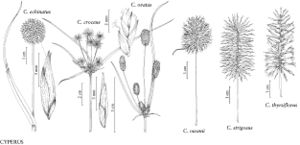Cyperus strigosus
Sp. Pl. 1: 47. 1753.
Herbs, perennial (often flowering first-year), rhizomatous. Culms basally swollen and cormlike, trigonous, (1–) 20–40 (–90) cm × 1–6 mm, glabrous or few prickles subapically. Leaves flat, (10–) 20–40 cm × 1–4 (–8) mm, margins and midribs glabrous or scabridulous. Inflorescences: spikes 1–4, loosely ovoid to oblong-cylindric; (6–) 10–28 (–50) × 10–40 mm; rays sometimes absent, usually (1–) 3–6 (–8), 0.5–7 (–25) cm; if absent, inflorescence a congested head; 2d order rays sometimes present, 1–4 (–9) cm; rachis 8–18 (–25) mm; bracts (3–) 5–7 (–10), ascending at 30–45°, cross ribs sometimes conspicuous, (1–) 10–30 (–45) cm × (1–) 2–4 (–12) mm; rachilla ± deciduous, wings 0.4–0.5 mm wide. Spikelets (5–) 12–50, linear-lanceoloid, compressed, 5–30 × 0.6–0.9 mm; floral scales ± deciduous, 3–11, appressed, medially green, laterally stramineous to pale-brown, 3–4-ribbed laterally, (1–) 3-ribbed medially, oblong-obovate, 3.2–4.5 (–6) × 1–1.8 mm, apex ± acute, overlapping lower 1/4–1/2 of next scale. Flowers: anthers 0.3–0.5 mm; styles 1–2 mm; stigmas 3–4 mm. Achenes purplish brown, ± stipitate, narrowly oblong, (1.5–) 1.8–2.4 × 0.5–0.6 mm, apex apiculate, acute, surfaces puncticulate.
Phenology: Fruiting summer.
Habitat: Pond shores, ditches, damp, disturbed soils, sometimes weeds of gardens or croplands
Elevation: 0–1500 m
Distribution

Man., Ont., Que., Sask., Ala., Ariz., Ark., Calif., Colo., Conn., Del., D.C., Fla., Ga., Idaho, Ill., Ind., Iowa, Kans., Ky., La., Maine, Md., Mass., Mich., Minn., Miss., Mo., Nebr., Nev., N.H., N.J., N.Mex., N.Y., N.C., Ohio, Okla., Oreg., Pa., R.I., S.C., S.Dak., Tenn., Tex., Utah, Vt., Va., Wash., W.Va., Wis.
Discussion
Cyperus strigosus is usually among the more common Cyperus species throughout its range. Small individuals flowering the first year may be difficult to distinguish from C. polystachyos, C. odoratus, C. erythrorhizos, and C. esculentus, which may be sympatric. Cyperus strigosus has trigonous achenes and three stigmas, unlike C. polystachyos; C. strigosus has flattened spikelets, unlike the subcylindric ones of C. odoratus; C. strigosus has floral scales usually 3 mm or more, unlike the smaller (1.2–1.5 mm) ones of C. erythrorhizos; C. strigosus has deciduous floral scales and a cormlike stem base with stolons, unlike C. esculentus.
Cyperus strigosus appears to be closely related to the neotropical C. camphoratus Liebmann; both species have deciduous floral scales and deciduous spikelets (G. C. Tucker 1994). Plants segregated as C. stenolepis cannot be distinguished consistently from C. strigosus on any single charcter, rather they appear to be merely large individuals of C. strigosus with long floral scales and frequently septate inflorescence bracts (M. L. Horvat 1941).
Selected References
None.
Lower Taxa
"shortened" is not a number.
